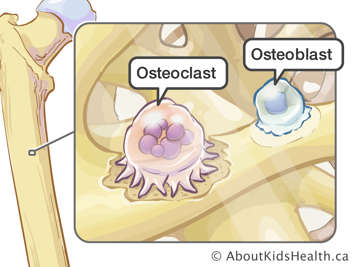Healthy bones contain collagen and calcium. Collagen is a protein that provides a soft, spongy framework to help bones stay flexible under stress. Calcium phosphate is a mineral that provides a hard outer surface to make bones strong.
How do bones change and grow?
Just like other organs in the body, bones contain living tissue that turns over (renews itself) regularly. Bone turnover happens in two steps: cells called osteoblasts build new bone and other cells, called osteoclasts, remove old bone and return the calcium to the blood stream.

Bone turnover happens right through a person's life, but it slows down as we get older. From childhood through the teen years, the body adds new bone more quickly than it can remove old bone. This helps to build bone mass, or bone density. From about age 20, however, our bodies add new bone more slowly. Eventually, we lose bone mass, as the body removes old bone more quickly than it can replace it.
Why is it important to keep my child's bones healthy?
Early childhood through the teen years is the main bone-building phase of your child's life. This is when your child's body adds the most calcium to their bones to help them become denser and stronger.
As a parent, you need to make sure that your child's bones have the best chance to stay strong right through their lives. Feeding your child a diet rich in calcium and vitamin D will help them add enough calcium to their bones. You can also help your child's bones get stronger by encouraging your child to do weight-bearing exercise.